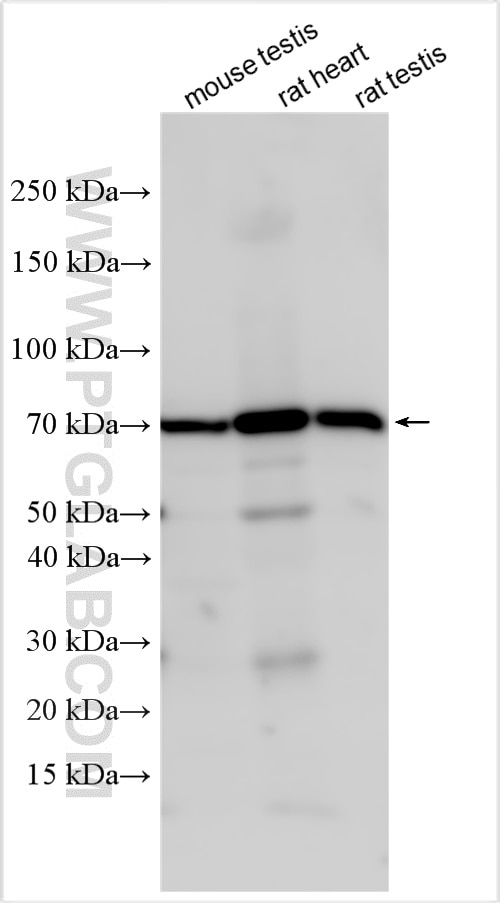Validation Data Gallery
Tested Applications
| Positive WB detected in | mouse testis tissue, rat heart tissue, rat testis tissue |
Recommended dilution
| Application | Dilution |
|---|---|
| Western Blot (WB) | WB : 1:500-1:1000 |
| It is recommended that this reagent should be titrated in each testing system to obtain optimal results. | |
| Sample-dependent, Check data in validation data gallery. | |
Product Information
14566-1-AP targets SIAE in WB, ELISA applications and shows reactivity with human, mouse, rat samples.
| Tested Reactivity | human, mouse, rat |
| Host / Isotype | Rabbit / IgG |
| Class | Polyclonal |
| Type | Antibody |
| Immunogen | SIAE fusion protein Ag6143 相同性解析による交差性が予測される生物種 |
| Full Name | sialic acid acetylesterase |
| Calculated molecular weight | 58 kDa |
| Observed molecular weight | 62-70 kDa |
| GenBank accession number | BC068450 |
| Gene Symbol | SIAE |
| Gene ID (NCBI) | 54414 |
| RRID | AB_3669189 |
| Conjugate | Unconjugated |
| Form | Liquid |
| Purification Method | Antigen affinity purification |
| UNIPROT ID | Q9HAT2 |
| Storage Buffer | PBS with 0.02% sodium azide and 50% glycerol , pH 7.3 |
| Storage Conditions | Store at -20°C. Stable for one year after shipment. Aliquoting is unnecessary for -20oC storage. |
Background Information
Sialic acids as terminal sugars of N- and O-glycosylated macromolecules are decisive for the functions of glycoconjugates both in soluble form and integrated into cell membranes .The two enzymes responsible for acetylation and de-acetylation have been described as sialate O-acetyltransferase (SOAT) and sialate O-acetylesterase (SIAE), respectively. SIAE deacetylates α(2-6)-linked sialic acid on N-linked glycans of BCR, allowing the interaction with CD22, that functions in vivo as an inhibitor of BCR signaling. (PMID: 26022516)
Protocols
| Product Specific Protocols | |
|---|---|
| WB protocol for SIAE antibody 14566-1-AP | Download protocol |
| Standard Protocols | |
|---|---|
| Click here to view our Standard Protocols |
